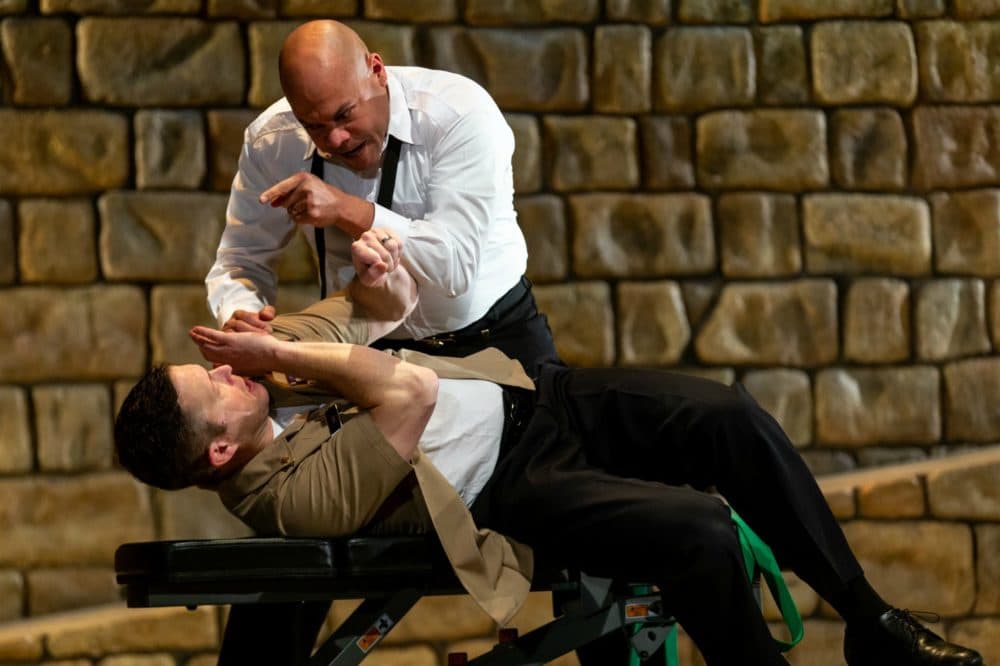Advertisement
Commentary
Amid A Reckoning With Toxic Masculinity, Seeing 'Othello' In A New Light

We can learn much from “Othello” about the gendering of hate, as a riveting production onstage at the American Repertory Theater powerfully shows.
Othello, referred to in the play as “the Moor” and represented as an outsider in productions for over 400 years, is the target of Iago’s manipulation. Audiences ponder the motive for Iago’s villainy. Is he enraged that Othello seemingly disregarded his hard work on the battlefield, then promoted another in his place and thereby earned his spite? Or is he a figure of pure evil, a classic psychopath as a lengthy tradition presents him?
No matter his motive, Iago is expert at enflaming racist stereotypes to rile others to persecute Othello, and sexist stereotypes of women’s deceptive nature to persuade Othello to doubt and then murder Desdemona, his wife. Whatever the extent to which he is gripped by these hatreds himself, Iago understands how effective they are as weapons of negative influence.
Watching this play in 2019 in the context of a long overdue reckoning with male violence is to see how misogyny is intertwined with racism and xenophobia, and is central to understanding what motivates violent men.

Iago’s manipulation and Othello’s transformation from loving newlywed to murderer are shocking. If we are to believe Iago, there are two reasons for his cruelty: revenge for sexual infidelity and professional jealousy of sorts. But neither explanation has struck most playgoers as sufficient, because Iago’s villainy bubbles up from seemingly irrational sources.
Yet, to a contemporary audience, Iago looks familiar.
Like many men who sexually abuse and harass women, who rape and murder girlfriends and wives, Iago blends in with acceptable masculine norms of behavior toward girls and women. Audiences have become conditioned to pose the question “Why does he do it?” about Iago, and to focus on the tangle of emotions that tie him to Othello. A fascination with violent men and a routine attribution of interest and significance to them makes this question central to an experience of the play.
But we have overlooked an equally urgent question: Why is Desdemona relegated to plot device? How does the habitual focus on violent men erase the victims of their violence? Why doesn’t the misogyny at the heart of Iago’s plotting garner more attention by playgoers?
How does the habitual focus on violent men erase the victims of their violence?
Our conditioning to accept misogyny as normal is surely part of the answer. To believe women faithless and men predatory by nature is one of our gender myths. Yet despite their fidelity, the women in the play are lumped together as mere copies of an original female identity: whore. Desdemona’s tragedy is not simply to be falsely accused, but to be named a whore. Through the name — and not her actions — she becomes the target of Othello’s unbounded rage.
Any woman can be falsely accused and once she is, it hardly matters who she might truly be or what she might have done. Caught up in this circular judgment with no access to exonerating facts, Desdemona becomes nothing other than the name she’s been called. Under that judgment, she falls victim to lethal intimate partner violence as Othello becomes judge, jury, and executioner of his “unfaithful” wife.
The #MeToo movement has opened a new acknowledgment of men’s sexual violence and a new level of accountability for it.
“Othello” makes it clear that women have been vulnerable to sexual slander and revenge for centuries. Rather than viewing the play as primarily about Iago’s obsession with Othello’s otherness, we need to see it as equally about misogyny, because sexual violence against remains a tragedy for far too many girls and women.
Many victims of intimate partner violence will recognize their experiences in this play. The terrifying transformation of a beloved into an aggressor, the closing off of escape routes, the urgent assertion of fidelity. The #MeToo movement opens up a new way to witness the play: to empathize with Desdemona and center her betrayal, entrapment and murder as a tragedy worthy of our greatest attention.

In the end, Othello does not believe Desdemona. Iago does not believe Emilia. And the final scenes of the play are conspicuously shocking: Othello murders Desdemona, Iago murders Emilia, Othello kills himself, and Iago is to be hauled off and tortured. It’s a sensationalistic and shameful spectacle.
The audience wants to look away. Not only because the violence should not have happened, but because this particular form of violence — intimate partner violence — is notoriously hidden within the symbolic walls that make domestic space a “man’s castle.” The heap of dead bodies on Othello’s bed is, in his own words, “too hideous to be shown.” Now we can view the play differently and center the tragedy of the victims to develop a moral gaze — from the outset — toward Desdemona’s and Emilia’s plight.
The #MeToo movement brings male violence against women center stage, and it marks a new period of learning to hear the testimony of victims.
"Othello" is at the Loeb Drama Center in Cambridge through Feb. 9.
